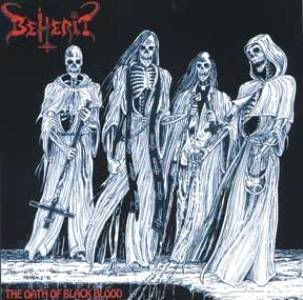 Black Metal is a genre that prides itself on raw production. This trend began when pioneering acts like Mayhem, Burzum and Bathory cut costs on production values due to budget constraints, but underproduction has since become arguably essential to the Black Metal ethos (Dimmu Borgir and Dark Funeral notwithstanding). Yet it is possible to have too much of a good thing (good, in this case, being a highly subjective quality).
Black Metal is a genre that prides itself on raw production. This trend began when pioneering acts like Mayhem, Burzum and Bathory cut costs on production values due to budget constraints, but underproduction has since become arguably essential to the Black Metal ethos (Dimmu Borgir and Dark Funeral notwithstanding). Yet it is possible to have too much of a good thing (good, in this case, being a highly subjective quality).Finland's Beherit was one of the lesser-known pioneering acts in the so-called Second Wave of Black Metal, and their obscurity is plain to hear--the production on this album is godawful (though some might consider that a compliment). The mix is horribly uneven, with the vocals overwhelming the instruments, the guitars so distorted as to sound like squealing breaks on a freight train and the drums often times inaudible. I can tolerate bad production, having listened to (and enjoyed!) my fair share of bootlegged Mayhem tracks in my day, but when the music is almost as poor as the production, even I can't think of the glass as half full.
The story behind this album is more interesting than the actual product--Beherit was granted a respectable--at least by underground standards--amount of money to record The Oath of Black Blood. Rather than do anything productive, the band instead opted to spend their budget on booze and drugs. Not all that shocking; indeed, this is the sort of things that rock bands have been doing at least since the 1960s. Without anything to show for their money, the record label opted to release a compilation of some of Beherit's old demo tracks, along with tracks from the band's earlier 7" EP (entitled Dawn of Satan's Millenium). The end result was The Oath of Black Blood, which has now come to be widely renowned and loved in the Black Metal milieu.
As unspectacular as the music might be, the album art is nevertheless suitably grim--it's hard to go wrong with skeletons in perverted ecclesiastical garb, after all. The artwork (as well as Beherit's logo) was done by Chris Moyen, who has provided artwork for quite a number of Black and Death Metal bands. I highly recommend you visit his website and have a look at his impressive body of work, which includes a hinger-quality version of the artwork featured above.
As for Beherit, they would thankfully improve. The Oath of Black Blood was succeeded by 1993's Drawing Down the Moon, a much better produced and much more interesting album. The band parted ways in 1996, after attempting a more ritualistic, ambient approach with their later work.
No comments:
Post a Comment